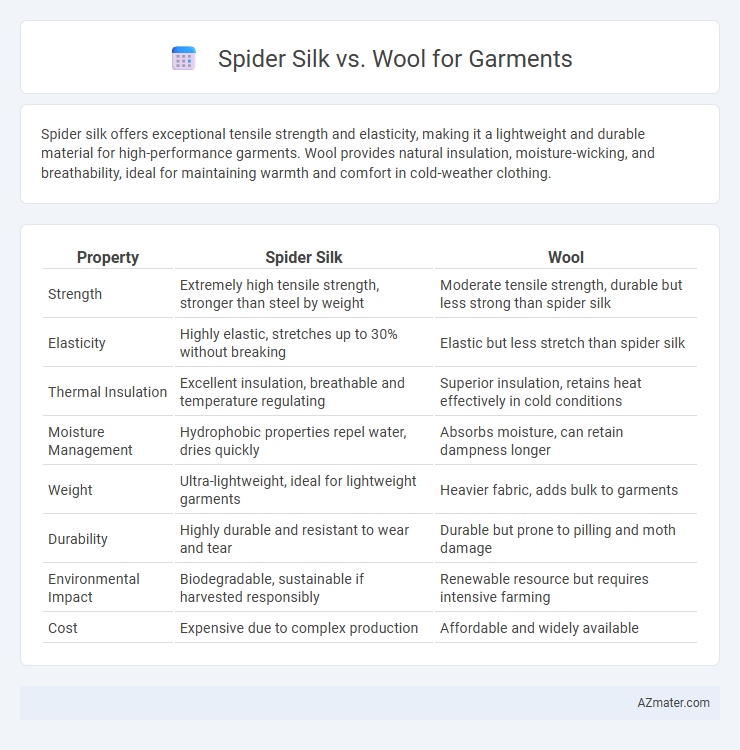Spider silk offers exceptional tensile strength and elasticity, making it a lightweight and durable material for high-performance garments. Wool provides natural insulation, moisture-wicking, and breathability, ideal for maintaining warmth and comfort in cold-weather clothing.
Table of Comparison
| Property | Spider Silk | Wool |
|---|---|---|
| Strength | Extremely high tensile strength, stronger than steel by weight | Moderate tensile strength, durable but less strong than spider silk |
| Elasticity | Highly elastic, stretches up to 30% without breaking | Elastic but less stretch than spider silk |
| Thermal Insulation | Excellent insulation, breathable and temperature regulating | Superior insulation, retains heat effectively in cold conditions |
| Moisture Management | Hydrophobic properties repel water, dries quickly | Absorbs moisture, can retain dampness longer |
| Weight | Ultra-lightweight, ideal for lightweight garments | Heavier fabric, adds bulk to garments |
| Durability | Highly durable and resistant to wear and tear | Durable but prone to pilling and moth damage |
| Environmental Impact | Biodegradable, sustainable if harvested responsibly | Renewable resource but requires intensive farming |
| Cost | Expensive due to complex production | Affordable and widely available |
Introduction: Spider Silk and Wool in Fashion
Spider silk, renowned for its exceptional tensile strength and natural elasticity, is emerging as a revolutionary material in high-performance fashion and luxury garments. Wool, a traditional textile fiber from sheep, offers superior insulation, breathability, and moisture-wicking properties essential for comfort in diverse climates. Comparing spider silk and wool highlights innovations in sustainable fashion materials that balance durability, comfort, and environmental impact.
Origins and Production Processes
Spider silk originates from orb-weaving spiders that produce protein-based fibers through specialized glands, harvested using advanced biomimetic spinning techniques due to spiders' territorial nature. Wool is sourced from the fleece of sheep, primarily Merino and other breeds, obtained by shearing and undergoing processes like cleaning, carding, and spinning to create yarn. While spider silk production involves biotechnological innovations to replicate natural spinning, wool relies on traditional agricultural practices and mechanical processing.
Structural Properties: Strength and Flexibility
Spider silk exhibits exceptional tensile strength and remarkable flexibility, surpassing wool's durability by a significant margin. The protein-based nanostructure of spider silk enables it to absorb energy efficiently, providing higher resistance to wear and tear in garments. Wool, while offering good elasticity and insulation, lacks the tensile strength and extensibility found in spider silk, making spider silk a superior choice for high-performance textile applications.
Thermal Regulation and Comfort
Spider silk exhibits superior thermal regulation compared to wool, as its nanostructure provides excellent moisture-wicking and temperature control, keeping the body cooler in heat and warmer in cold. Wool, while naturally insulating and moisture-absorbent, can retain dampness longer, potentially leading to discomfort in humid conditions. The lightweight and breathable properties of spider silk enhance comfort by reducing sweat-induced irritation and promoting airflow, making it ideal for high-performance garments.
Moisture Management and Breathability
Spider silk exhibits exceptional moisture management by efficiently wicking sweat away from the skin, promoting faster evaporation and maintaining dryness. Its unique protein structure allows superior breathability compared to wool, enabling better air circulation and temperature regulation in garments. Wool, while naturally moisture-wicking, tends to retain more moisture and dries slower, making spider silk a more advanced choice for performance apparel focused on comfort and ventilation.
Sustainability and Environmental Impact
Spider silk offers superior sustainability compared to wool due to its biodegradable properties and minimal resource requirements for production, reducing environmental strain. Wool production involves significant land use, water consumption, and methane emissions from sheep, contributing to higher greenhouse gas footprints. The innovative cultivation of spider silk via bioengineered microorganisms promises scalable, eco-friendly textile alternatives with lower carbon emissions and less chemical processing than traditional wool.
Allergenicity and Skin Sensitivity
Spider silk exhibits exceptional hypoallergenic properties, making it ideal for sensitive skin and reducing the risk of irritation compared to wool. Wool contains lanolin and other proteins that can trigger allergic reactions or itchiness, especially in individuals with sensitive or reactive skin types. Its smooth, protein-based fibers create a breathable, non-irritating barrier that enhances comfort for allergy sufferers.
Durability and Longevity
Spider silk is renowned for its exceptional tensile strength and elasticity, making garments highly resistant to wear and tear compared to wool. Wool fibers, although durable and naturally resilient, are more susceptible to pilling and degradation over extended use and frequent washing. Consequently, spider silk garments offer superior longevity, maintaining structural integrity and appearance far longer than traditional wool clothing.
Cost, Accessibility, and Market Trends
Spider silk offers superior strength and elasticity but faces high production costs and limited scalability compared to wool, which remains affordable and widely accessible due to established farming and manufacturing infrastructure. Wool dominates the garment market because of its natural insulation, moisture-wicking properties, and renewable sourcing, making it a cost-effective choice for mass production. Emerging advances in bioengineering spider silk aim to reduce costs and increase availability, potentially shifting market dynamics as sustainable and high-performance textile demand grows.
Future Innovations in Textile Technology
Spider silk's exceptional strength, elasticity, and biodegradability position it as a revolutionary material for sustainable garment production, potentially surpassing traditional wool in durability and environmental impact. Future innovations in recombinant DNA and synthetic biology are enabling scalable spider silk production, offering lightweight, moisture-wicking, and thermoregulating properties that wool cannot replicate. Emerging textile technologies integrating spider silk aim to create advanced performance wear combining natural resilience with cutting-edge comfort and eco-friendly attributes, driving a new era in functional fashion.

Infographic: Spider silk vs Wool for Garment
 azmater.com
azmater.com